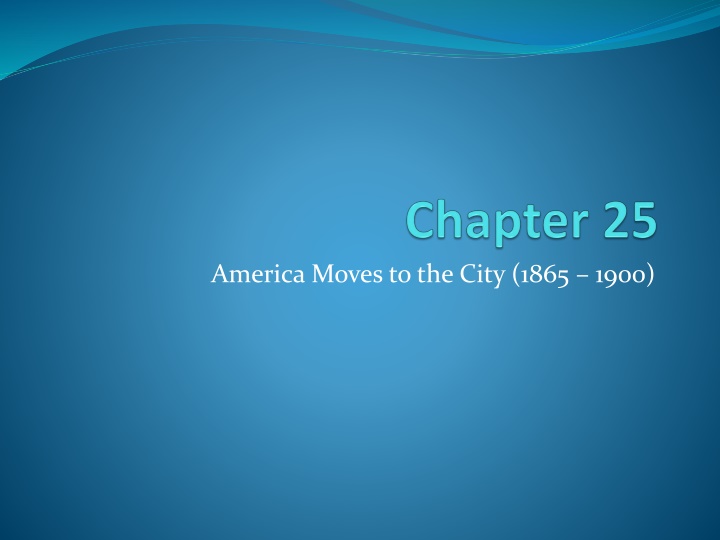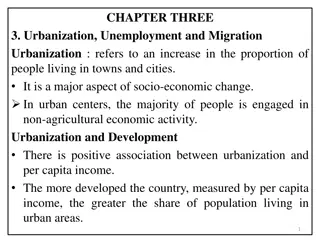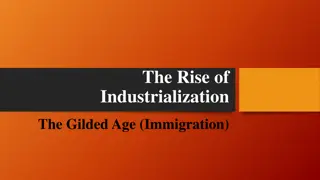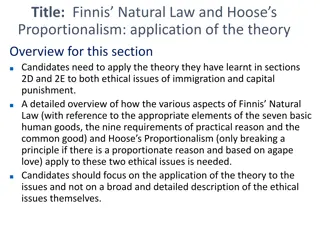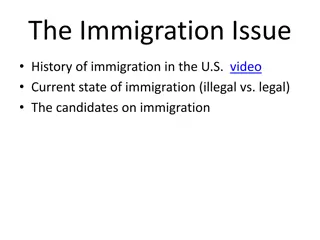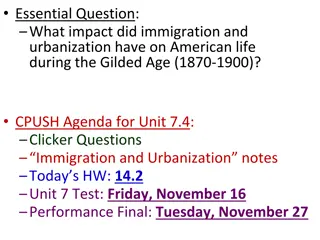Urbanization and Immigration in America (1865-1900)
America experienced significant urbanization and immigration between 1865 and 1900. Cities grew rapidly, attracting people from rural areas seeking industrial jobs and economic opportunities. The influx of immigrants from Southern and Eastern Europe brought about social tensions and challenges, as they faced issues of assimilation and nativism. Social reformers like Jane Addams and initiatives like Hull House emerged to address the social issues in the growing urban centers.
Download Presentation

Please find below an Image/Link to download the presentation.
The content on the website is provided AS IS for your information and personal use only. It may not be sold, licensed, or shared on other websites without obtaining consent from the author.If you encounter any issues during the download, it is possible that the publisher has removed the file from their server.
You are allowed to download the files provided on this website for personal or commercial use, subject to the condition that they are used lawfully. All files are the property of their respective owners.
The content on the website is provided AS IS for your information and personal use only. It may not be sold, licensed, or shared on other websites without obtaining consent from the author.
E N D
Presentation Transcript
The Growth of Cities 1stsky-scraper built in Chicago in 1885 Aspects of cities Electric trolleys Residential neighborhoods segregated by race Industrial jobs drew people from the country Cities gave women economic opportunity and independence Social workers, secretaries, stenographers, etc.
Rural general stores replaced by Sears and Montgomery Ward mail order catalogues What stores are replacing mom and pop stores today? Issues in city life Waste disposal Criminals flourished Uncollected garbage Population explosion Tenement housing
The New Immigration Old Immigration: Before 1880 Mostly British and Western European Usually Protestant (some German and Irish Catholics) High rate of literacy Adjusted to American life pretty easily New Immigration (1880-1920) Southern and Eastern Europe (Italy, Croatia, Greece, etc.) Mostly illiterate, poor, and likely to work in cities Tensions mount between New and Old
Reasons for Immigration Europe s population increasing at drastic rates, many unemployed people Why did they move here? American letters No military conscription here Free from institutionalized religious persecution Birds of Passage Many Jews were forced to leave Tailors and shopkeepers
Reactions to the New Immigration Mostly ignored, except by political bosses. Rewarded with jobs Tammany Hall Social Crusaders attempted to improve the "shame of the cities" Walter Rauschenbusch and Washington Gladden Insisted that churches tackle social issues Jane Addams **Hull House** (Settlement House) 1893: Illinois passes anti-sweatshop law Most working women were single. Why?
Examples of Nativism Most New immigrants came for same reasons as Old; to escape poverty More concerns about New immigrants: APA, Why are you hating, bros? High birthrate Anglo-Saxons could be outvoted and outnumbered Radical ideas such as socialism, communism, anarchism, etc. Just like Know-Nothings, anti-foreign groups emerge American Protective Association (APA) urged voting against Catholics
More Immigration stuff New immigrants were used as strikebreakers Immigrants were hard to unionize (language) 1882: Chinese Exclusion Act (Chinese not part of New immigration) Literacy tests were proposed for immigration, but not enacted until 1917.
The Social Gospel Social Gospel: Church movement to improve conditions affecting society YMCA YWCA were formed by churches
The Lust for Learning Who helped influence and spread education? Horace Man By 1900, high schools were increasing drastically Free textbooks supported by taxpayers Private Religious schools Illiteracy rates dropped from 20% in 1870 to 10.7% in 1900
Key African Americans Booker T.: Ex slave, believed Blacks should be educated in trades so they could gain self-respect and economic security Labeled Accommodationist someone who seeks compromise Called Uncle Tom by W.E.B. Du Bois W.E.B.: Ph.D. from Harvard Demanded immediate political equality for Blacks Helped found NAACP Differences reflected the contrasting life experiences of southern and northern Blacks
Development of New Schools Morrill Act of 1862: Granted public land to states for support of education Hatch Act of 1887: Provided federal funds for establishment of agricultural experiment stations New colleges and Universities develop Cornell Johns Hopkins
The Role of the Press Sensationalism: Public interested in sex, scandal, and human interest stories Yellow Journalism: Exaggerating/making up stories to sell newspapers Hearst and Pulitzer
Key Books and Authors to Know Edward Bellamy: Looking Backward, government nationalized big business to serve interest of public ***Horatio Alger*** Wrote that virtue, honesty, and industry are rewarded by success, wealth, and honor Rags to Riches stories Frank Norris The Octopus, RR and corrupt politicians Jacob A. Riis -- How the Other Half Lives (1890) Photo-journalist who exposed dirt, disease, vice, and misery of rat-infested New York slums
Thats it! Subscribe to my channel Help spread the word Questions? Comments? Ideas for videos? Email or leave in comments Subscribing to this channel equals WINNING!
